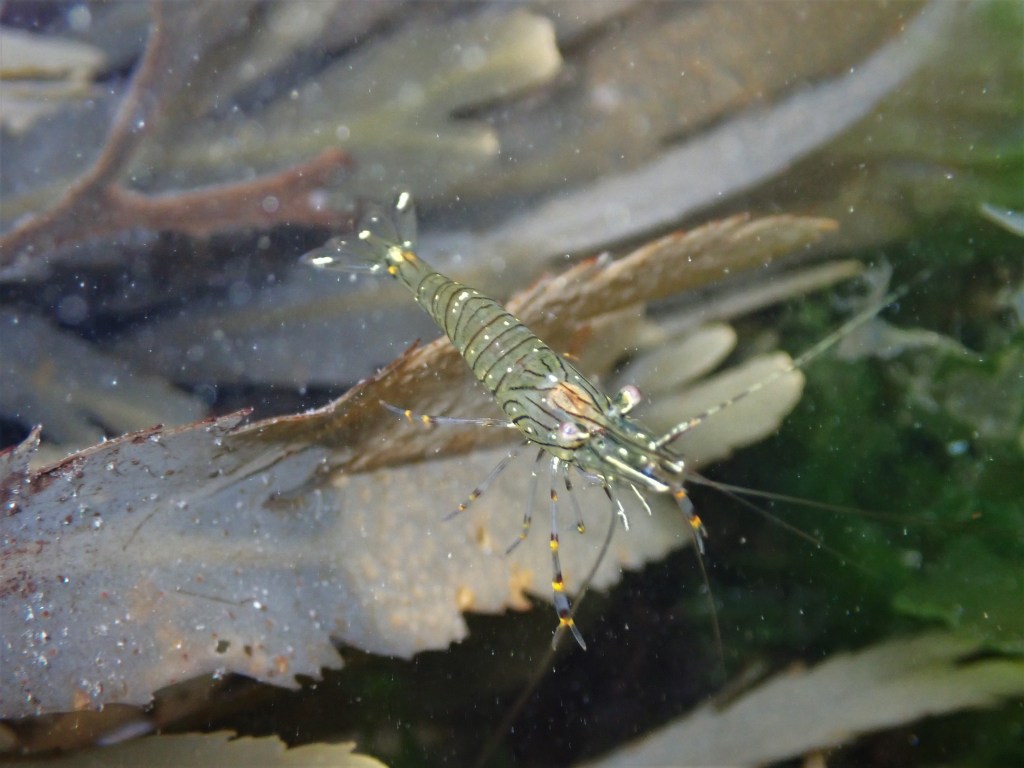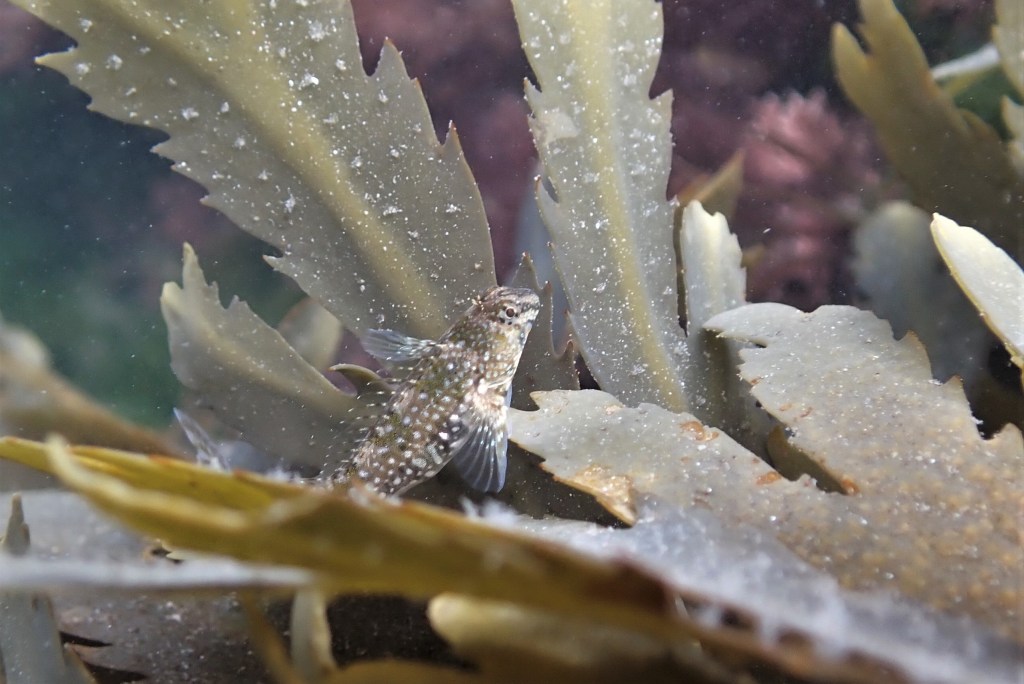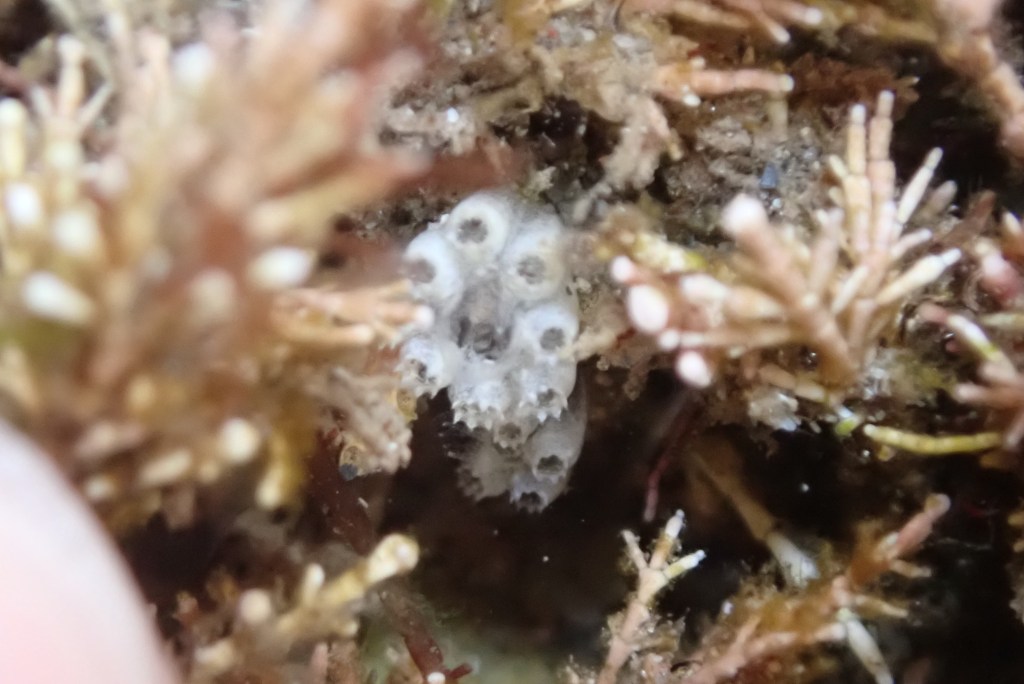Days like this don’t seem ideal for rock pooling; the tide is nowhere near low enough to expose my favourite pools and the weather is iffy. Despite this, I am convinced that there is plenty to see on the mid-shore. Cameras and rock pooling super-crew (Other Half and Junior) at the ready, we set out to uncover marine treasures.
One advantage of neap tides, when the sea doesn’t go out very far, is that it won’t rush back in either. We can take our time. Junior soon locates lots of gem anemones with their tentacles wide open.
Under a stone further down the shore, I spot a beautifully camouflaged anemone. It’s too small to see properly, so I have to wait until I get home to confirm that it’s a Sagartia troglodytes anemone.
The B shape at the base of the tentacles is a useful identifying feature, although I’ve always thought they look more like Scooby Doo ghost eyes than letters.
Other Half calls me over to look at a blob. He’s becoming quite an expert blob finder.
We look together at the tiny brown jelly-spot on the seaweed. At first, we think it is an anemone because it seems to have a circle of retracted tentacles. As soon as I dunk it in the water though, I can see the pale lumps of primary tentacles around the edge. It must be a stalked jellyfish.
Gradually, the stalked jelly unfurls each arm until it looks much less blob-like.
The rain seems to be holding off now, and I make myself comfortable by a calm pool to watch the little world go by. My camera has barely entered the water before a bold prawn trots out of the seaweed, its legs working at top speed in its eagerness to check out what I’m up to.
A head pops up between the fronds of saw wrack at the back of the pool. The young Montagu’s blenny swivels an eye back and forth beneath its jaunty headgear. I feel a larger blenny move through the seaweed near my hand and lift my camera out of the water before I get a nip from the territorial shanny.
A dinky starfish in the coral weed catches my eye. I see several species of starfish on this beach, but this is a mid-shore specialist: Asterina phylactica. The colours of the tiny pincers on its back (the pedicellariae) form an orange star shape. Under the camera, I can see its tube feet reaching out and exploring its surroundings as it glides along.
Other Half brings passes me a tiny shell he has found. He thinks it might be a wentletrap, a shell we sometimes find. I have never seen one so small and assume it is probably a different species. I take a look with the camera and realise he was right. The bold sculpture of ribs over the rounded whorls of the long spire are striking, even in this tiny juvenile. Best of all, the shell is occupied.
I watch the snail emerge and set off across the pool.
Sea squirts are something of an enigma to me. They are hugely varied in their colours, shapes and sizes. Aplidium turbinatum, in particular, seems to me to look different every time I find it. When I first see this one, I am convinced that the white, spiky-looking set of openings under the coral weed is a bryozoan.

Yet, after a while watching it, I realise it is opening and closing like a squirt, puffing water in and out. It bears little resemblance to the orange gelatinous Aplidium turbinatum I usually see further down this beach, but the jutting triangular crowns around the edge of each opening are the same.
Fortunately, I can turn to the incredible Aphotomarine website for confirmation and, sure enough, it has some photos of very similar specimens (thanks David!).
While the tide seeps back into the pools, we chat with a fellow rock pooler whose photos I have often seen online, and who I eventually realise I have met before in real life through another conservation group.
By the time we leave, the sun is low in the sky. I am more than satisfied with all the wonderful creatures I have found on the neap tide, and it is high time I had some birthday cake.
Whatever the tide, always stay safe in the rock pools. Follow my rockpooling tips to look after yourself and the wildlife on the shore.
This website is a labour of much love and the content is available for free to everyone. My wonderful readers often ask if there is a way to support my work. You can now ‘buy me a coffee’ through my Ko-fi.uk page. (Just click donate and you can set the amount to pay by PayPal). Thank you!
















What a lovely way to spend your birthday – glad you got some quiet rock pool time x
LikeLiked by 1 person
It was perfect! I had planned to go swimming as I usually do for my birthday, but for the first time I can remember, the weather wasn’t good enough. No matter… rock pooling always makes me happy. I did find some sea slug spawn but no slugs. Next time! 🙂
LikeLike
Happy birthday! What a lovely way to spend the day. Thank you so much for the link to the amazing website, that will also give me hours of pleasure xx
LikeLiked by 1 person
Thank you Trisha 🙂 David Fenwick’s Aphotomarine website is a fabulous reource and a work of true genius! He’s spectacularly knowledgeable and is generous in sharing that through his website and support for others. He’s a total hero!
LikeLike